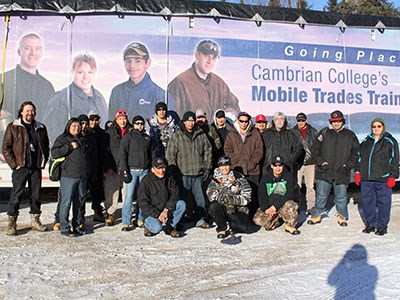Peter Pagnutti is spending 12 weeks introducing an enthusiastic class of First Nation students to the skilled trades, but the Cambrian College instructor readily admits the whole experience has been as equally rewarding for him.
“There's not a day goes by where I don't strike up a conversation with one of them and they teach me something,” particularly in feeding Pagnutti's abiding interest in natural remedies.
Sudbury's Cambrian College is providing hands-on learning to 15 students from Webequie through an introduction to the trades course geared toward eventually graduating heavy equipment mechanics.
The remote community of Webequie in the James Bay lowlands is the closest settlement to the Ring of Fire, the area of Ontario's next great mining camp.
Last winter, the Ontario government announced $3.1 million in training funds to prepare residents for future job opportunities in six First Nation communities in the Far North, including Webequie.
With Noront and Cliffs Natural Resources aboard as industry partners, the training focus was on heavy equipment operation, pre-employment training and general educational purposes.
Thunder Bay-based Oshki-Pimanche-O-Win Education and Training Institute received $590,000 of that money for Mining Essentials, an industry-recognized work readiness program.
Cambrian College is delivering some of that training through the use of its mobile trades training trailer.
But dodgey conditions on the winter road meant the trailer never made it up to Webequie.
Instead, it was parked a half-hour's drive west of Hearst at Eagle's Earth, an eco-tourism resort near the Constance Lake First Nation, with an adjoining modular classroom.
The course started Feb. 25 and was scheduled to wrap up March 21. Pagnutti's class of 15 ranged in age from folks in their late teens to middle-aged students, including one woman.
“They're very gung ho and enthusiastic,” said Pagnutti, who's been introducing students to specialty tools such as torches, welding machines and various impact tools.
“They've got excellent work ethic, very punctual and reliability.” Their mechanical aptitude is limited to the basic hand tools they use to fix the community's vintage snowmachines.
“If I were to do it again, I'd bring a lot more materials with me because they just love working with the tools,” he said. “The finger dexterity is noticeable, especially when you watch them use the tools and spin bolts in and out.”
Though they sometimes struggle in math, Pagnutti is impressed with their diligent and precise note taking.
“They're not sitting there playing with their cell phones, they're actually paying attention.”
Pagnutti said it's plainly evident his students enjoy working with their hands.
“It's break time and nobody moves. They just keep welding and burning and doing whatever they're doing.”
Pagnutti previously taught a course in Kirkland Lake to Aboriginal people from nearby Matachewan, but this is his first experience working with students from a remote community.
“What I'm learning a lot about is their spirituality and the way they listen to their elders. There's an unbelievable amount of respect toward them.”
During a brief break in Sudbury, Pagnutti was hoping that all of his class would return on the following Monday.
Many were homesick for their families, some being away from Webequie for the first time.
“It seems the more remote they are, the closer they are.”
On his one day spent in Webequie, Pagnutti found residents very open and friendly. Their remote lifestyle was tough to fathom, giving Pagnutti a new-found respect for the resilience and the hardiness of the people, especially when the community's diesel generator goes down for a week.
“You know what happened when our Ontario grid went down in August (2003) for a day-and-half. Can you imagine this for a week at this time of year? To them it was nothing, burn some wood, stay warm and catch some rabbits. They know how to survive, there's no doubt about that.”
The mining industry is looking to Aboriginal people to fill the ranks of the workforce needed to develop new mines, especially in the Ring of Fire in the James Bay lowlands.
“Cliffs is going to need heavy equipment people, millwrights and welders,” said Pagnutti. “Welding is a good trade to know because it doesn't require a lot of high-end education but you need the basics of the trade and the rest is practice.”
Oshki-Pimanche-O-Win executive director Rosie Mosquito said the enthusiasm for skilled trades training is spreading among the remote communities of the Nishnawbe Aski Nation (NAN).
During a recent visit to Sandy Lake First Nation, many in the community were asking about the program. “It's creating a lot of buzz, a lot of excitement and there is a great need for it.”
Oshki was created in 1996 by NAN's development corporation as a post-secondary institute offering a wide range of training. Last year, Oshki graduated) 55 students, its largest class ever.
“I always believe in reaching high,” said Mosquito. “From the get-go, we wanted a high success rate and commitment to get really good outcomes.”
In scoping out opportunities in the Ring of Fire, Oshki employed Cambrian College to take the trades training to the communities.
“Not everyone is academically inclined so to provide this kind of training really fills the gap for those who like hands-on or visual training.”




